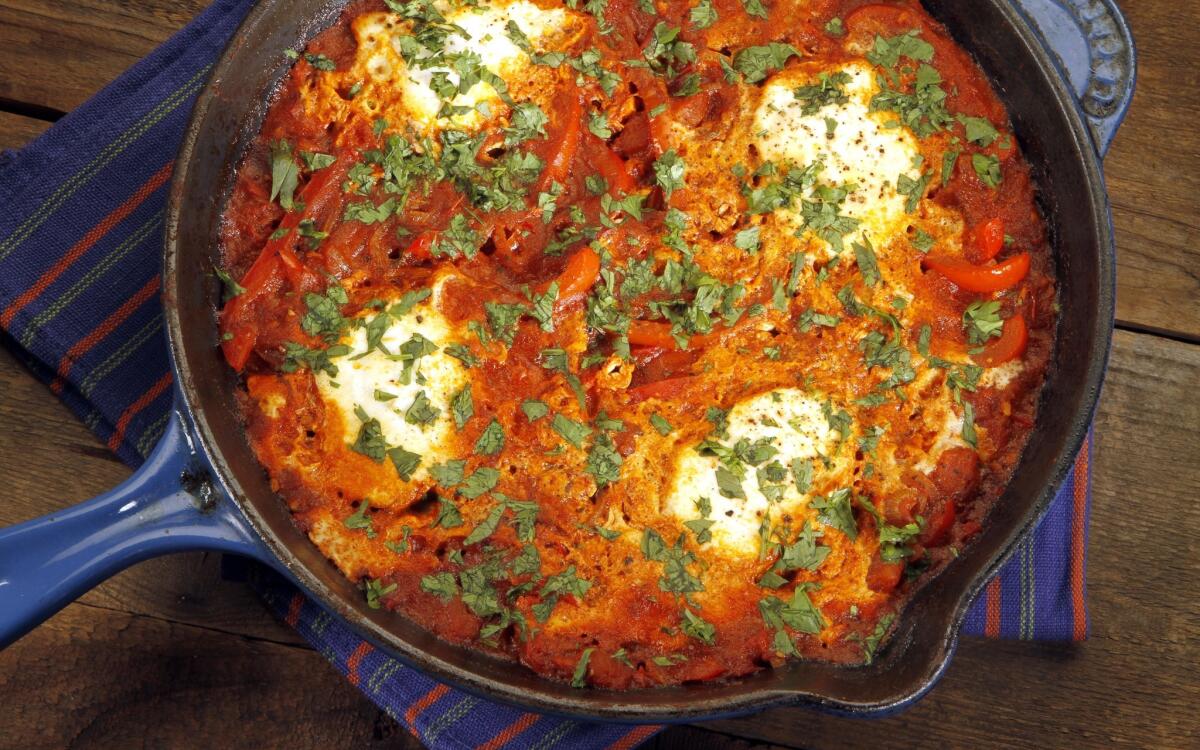Shakshuka

- Share via
All of a sudden, the whole world seems to be going shakshuka. And that’s a good thing. Seriously.
Once beloved only by cooks who follow Middle Eastern traditions, shakshuka — essentially eggs cooked in a spicy tomato sauce — had a breakout moment a couple of years ago, thanks to Yotam Ottolenghi’s cookbook “Plenty.”
Granted, that popularity boom hasn’t been quite so heated as the run on eggplants inspired by the book’s cover photo, but shakshuka is definitely turning up in places it never had before. Like my house.
After several months of playing around with the dish, I decided to get serious and really try to understand it. That required several weeks of testing shakshuka recipes from various sources, and after going through pounds of peppers and tomatoes and a couple dozen eggs, I’m here to say quite definitively that shakshuka is delicious — however you fix it.
In reality, shakshuka is more an idea than a recipe. Like so many traditional dishes, it is almost infinitely variable, adapting itself to the tastes of different countries, regions, cities, families and even individuals. It’s no more a single recipe than, say, “spaghetti with tomato sauce” is.
The most basic recipe I tried was from Claudia Roden’s encyclopedic “The New Book of Middle Eastern Food”: fry peppers, add garlic and tomatoes, drop in the eggs. But because this is shakshuka, she also has variations: variously adding harissa, caraway seeds, preserved lemon, capers, cooked potatoes, zucchini, eggplant, onions and — one that I’m going to file away for later — frying it with merguez sausages.
Most of the recipes I found included some kind of bell pepper, but there were many that did not. There’s not even any definitive agreement on how the dish should be spelled in English. Some prefer chakchouka, others go with shakshouka. Transliteration, like cooking, is an art, not a science.
If you want a perfect example of how diverse shakshuka recipes can be, you need only compare the two most recent Ottolenghi books.
In 2010’s “Plenty,” the version that drove the dish’s recent popularity, the tomato sauce is flavored with a very complex, fairly restaurant-y combination of onions, red and yellow peppers, sugar, bay leaves, fresh thyme, parsley, cilantro, saffron and cumin.
In “Jerusalem,” which came out in 2012, the shakshuka comes from his co-writer and business partner Sami Tamimi and is a more stripped-down version, that complex spicing abbreviated by the substitution of harissa, with only cumin added.
In testing the recipes, I learned that I like peppers in my tomato sauce — they add sweetness and a certain silky texture. I like harissa for heat and complexity (brands vary in spice, start low and add more to taste). I like cumin, which adds an earthy bitterness to the chile heat.
And, in my own addition to the shakshuka scramble, I add a little bit of Spanish pimenton de la Vera — radical, perhaps, but the smokiness adds another layer of complexity.
It’s my shakshuka and I’ll add it if I want to. I’m just following tradition.
Heat the oil in a skillet over medium heat. Add the sliced peppers, salt lightly and cook, stirring frequently, until the peppers have wilted and begun to soften, about 5 minutes.
Add the onion and cook until it has softened, about 5 minutes, then add the garlic and continue cooking until that becomes fragrant, about 1 minute.
Add the harissa, tomato paste and cumin and cook until the mixture becomes richly fragrant, about 3 minutes. Add the chopped tomatoes and the pimentón and cook until the mixture forms a thick sauce, about 7 minutes. Season to taste with salt and pepper and add more harissa if desired.
Using the back of a spoon, make 4 depressions in the sauce and crack an egg into each. Sprinkle lightly with salt, cover the pan and cook until the eggs are set, about 10 minutes.
Sprinkle chopped cilantro over the top and serve immediately, with labneh or Greek yogurt on the side.
Get our Cooking newsletter.
Your roundup of inspiring recipes and kitchen tricks.
You may occasionally receive promotional content from the Los Angeles Times.















